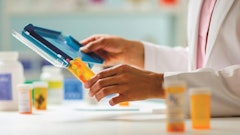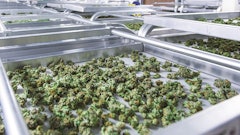
As cultivators ourselves, when we have a problem, we like to look to producers of other products for ideas and solutions. We have noticed conventional businesses, which make conventional products, rein in their testing costs and still receive predictable and consistent results. How is that?
Their solution: control
For better or worse, the testing model that assures product safety and integrity at a reasonable cost has already been invented by conventional product producers. In general, the model requires that the entire production process operate in a state of control, meaning all inputs and values are known and accounted for before the process starts. With a production system under control, the model moves routine testing in-house, which should be one of our industry’s major goals.
Food and Drug Administration (FDA)-regulated consumer packaged goods in America, including food, cosmetic and pharmaceutical products, produced by companies operating in a state of control, are tested exclusively in-house at a fraction of the cost that cultivators regularly spend on testing. A conventional American company that is regulated by the FDA would only outsource testing after determining that a particular test is so seldom required that it would not be worth buying the necessary equipment nor hiring the necessary staff. The conventional company’s control will be audited occasionally by its commercial customers and by the FDA, but it spends a fraction of what the cannabis industry spends on testing. Let’s look at the work that creates control.
Characterization
The basic control model starts with the concept of product characterization. For example: What is the product’s appearance? Is it flower or a concentrate? How should it look in its final form? Once we know this information, we can establish performance specifications and technical attributes of our product.
Those technical attributes are discovered through identity testing. Hundreds of potentially active ingredients are present in cannabis, but we, the cannabis industry, are focused primarily on cannabinoids and terpenoids. Do we want to test only for THC and CBD and a few major terpenoids, or are we interested in testing for more? Our company, for example, tests for the presence of a dozen cannabinoids and 42 terpenoids. The more we know about our product, the more predictable an experience we can produce for our patients.
Product performance evaluations include stability testing. As consumers in America, we rely on product expiration dates. Daily, we gauge freshness in terms of “use by,” “packaged on,” “best by” or “expires on” dates. The same concept should apply to cannabis. We all know about the degradation of tetrahydrocannabinol (THC) to cannabinol (CBN), but many other time- and temperature-driven oxidation reactions can affect a cannabis product over time.
But before we concern ourselves with product identity testing and product stability, we should consider raw material testing, in-process testing and adherence to good manufacturing practices (GMPs). We should characterize our process input materials as well. Is our guano sourced from a reliable supplier, or might we experience lot-to-lot variation such as higher nitrogen levels from time to time? Should we concern ourselves with a salty precipitate at the bottom of a jug of liquid fertilizer? Maybe the amendment manufacturer has a reliable manufacturing process, but the regional distributor bulk stores pallets in a metal building in Arizona during summer. What might the impact be on our flower?
Basically, characterizing all products, and the inputs that go into making those products, will allow us to accurately predict quality characteristics about our products even before the testing results come back from the lab.
Sampling
Sampling is the next step in proving to ourselves and others that we are operating in a state of control.
The cultivation inputs that we bring in and the products that we ship out constitute populations of material, with some differences in density, moisture content and other matters. Following characterization, sampling methodology defines how we estimate, as best we can, what we’re working with. Sampling acknowledges that every bit of guano is not identical, and that every bud is not exactly the same as every other bud, even when they come from the same 20-percent-THC strain. Different sampling methodologies might explain some of the reported differences in test results for products sent to different labs. Virtually every test that we perform requires us to sample something. Our sampling methodologies are designed to tell us that our test results accurately represent our test subjects.
Consider pulling a single, random sample as the representative sample of 100 plants in a flower room. If we test that sample, we’ll get a result, but there is no guarantee it will be a result that accurately reflects all 100 plants. If, instead, we divide those plants into clusters of 10 plants and choose a sample from each cluster, we might get a better estimate of our population. If we zoom in further and take a stratified sampling approach in which we only collect samples from the top cola of plants from each group, we’ll likely increase our characterization accuracy even further.
How and when to sample are just as important as how much to sample. If we collect a microbiological sample into a non-sterile container without using an appropriate aseptic technique, then we could receive a false positive (bad) result. Opposite to this is a false negative, which occurs when a test fails to identify a contaminant due to the presence of a masking agent (also bad). Maybe an ingredient in the formula blocked the test method’s ability to detect the target substance. Therefore, we must conduct product validation to ensure that our product doesn’t enhance or interfere with the test method.
There are many moving parts to consider. Most of this isn’t mandatory in our industry yet, but it’s coming. And before the industry can move product-quality testing to in-house laboratories, we’ll need to prove that we understand these concepts and have documented methods in place for them.
More To It
To begin testing in-house, the methodology concepts make further demands. Nevertheless, understanding these methodologies and bringing testing in-house does not mean that every one of us will become a laboratory director. As cultivators, we are comfortable knowing that our electricians and our plumbers understand things about electricity and plumbing that we do not. We know something about characterization and sampling, but our lab director knows more.
The additional demands for laboratory work include equipment qualification for its purpose, equipment result validation (comparable results from the same equipment across different operators), and installation qualification, operator qualification and process qualification for each piece of analytical equipment. And, of course, annual operator proficiency testing.
Getting through these methods will result in a 20-percent-THC strain testing at 20-percent-THC, no matter who uses the instrument to run that test. We won’t always know everything about the material that we are testing before we start, but we will know something (e.g., the target cannabinoid content being 20-percent THC). That something is extremely relevant. When we find a needle in a haystack, we are supposed to know that the needle is not another piece of hay. And when we find a needle in the haystack, we need to throw out the haystack.
The overall concept and methodology of control runs upstream and downstream from our grow. Looking upstream, all our inputs arrive with certificates of analysis. Our most significant inputs require three batches of full-release testing to validate. (Connecticut adopted FDA standards for its medical cannabis industry.) After three batches of full-release testing, assuming consistently compliant test results, we deem it acceptable to reduce our work and our costs. We continue with identity testing of incoming ingredients and—as appropriate—microbiological, heavy metals or other testing for contaminants, with only one lot per year subject to full-release testing on an audit basis.
Downstream, beyond good record keeping practices for everything that we do, our concern for what happens to all our products in our packaging prompts us to retain samples for each batch and to conduct stability testing. What happens in our packaging after a month? What happens at temperatures greater than 90 degrees Fahrenheit? We have the retained samples and the test results. We like controlling our risks by knowing that the products we ship to our customers are safe and consistent and that our products are exactly what their labels say they are.
The other logical result of all this work is a great reduction in testing costs. Once we can support our confidence in our control over inputs and outputs, we can move to periodical audits (as mentioned above) of samples of incoming materials and into more selective testing of finished products.
To achieve this, we must persuade our regulators that our methods and systems are just as good as the methods and systems used by conventional businesses that do their testing in-house. We should reach that goal. In general, that is how American producers of consumer-packaged goods operate.























